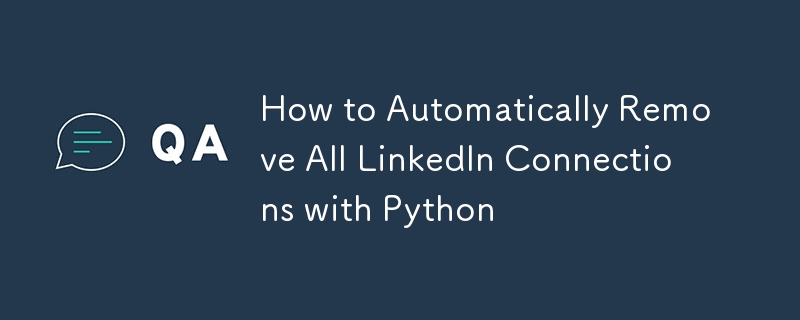 Backend Development
Backend Development
 Python Tutorial
Python Tutorial
 How to Automatically Remove All LinkedIn Connections with Python
How to Automatically Remove All LinkedIn Connections with Python
How to Automatically Remove All LinkedIn Connections with Python

Are you tired of manually removing LinkedIn connections one by one? It can be time-consuming and frustrating, especially if you have hundreds or even thousands of connections that you no longer need. Well, I’ve created a solution for you!
With this Python script, you can automatically remove unwanted LinkedIn connections with just a few lines of code. This script uses Selenium to interact with LinkedIn’s web interface, mimicking human behavior, and automating the process of removing connections. No need to worry about account bans, as the script simulates human-like interaction with pauses between actions.
Key Features:
- Automates the Removal of LinkedIn Connections: Save time by removing unwanted connections in bulk.
- Human-Like Interaction: The script waits between actions, ensuring that LinkedIn doesn’t flag your account for suspicious activity.
- Easy to Use: Simply input your login credentials, run the script, and let it do the rest!
How It Works:
- Login to LinkedIn: The script logs into your LinkedIn account using your email and password stored in an .env file for added security.
- Navigate to Connections Page: It goes directly to your LinkedIn connections page, where all your connections are listed.
- Click and Remove: For each connection, the script clicks the "More" button, selects "Remove Connection," and confirms the removal.
- Continuous Removal: The script continues to remove connections one by one with pauses between actions to simulate human behavior.
How to Use:
- Clone the repository or download the script from the GitHub link.
- Set up your environment by installing the required dependencies and creating a .env file with your LinkedIn credentials.
- Run the script, sit back, and let it do the work!
Requirements:
- Python 3.10.x
- Selenium
- Firefox
Final Words:
This script is a simple yet powerful tool for anyone who needs to clean up their LinkedIn connections. Whether you’ve added people by mistake or just want to declutter your network, this script will save you time and effort.
If you found this post helpful, make sure to like and comment below. Don’t forget to check out the full script on Blog and watch the video tutorial here.
Happy coding! ?
The above is the detailed content of How to Automatically Remove All LinkedIn Connections with Python. For more information, please follow other related articles on the PHP Chinese website!

Hot AI Tools

Undresser.AI Undress
AI-powered app for creating realistic nude photos

AI Clothes Remover
Online AI tool for removing clothes from photos.

Undress AI Tool
Undress images for free

Clothoff.io
AI clothes remover

Video Face Swap
Swap faces in any video effortlessly with our completely free AI face swap tool!

Hot Article

Hot Tools

Notepad++7.3.1
Easy-to-use and free code editor

SublimeText3 Chinese version
Chinese version, very easy to use

Zend Studio 13.0.1
Powerful PHP integrated development environment

Dreamweaver CS6
Visual web development tools

SublimeText3 Mac version
God-level code editing software (SublimeText3)

Hot Topics
 How to solve the permissions problem encountered when viewing Python version in Linux terminal?
Apr 01, 2025 pm 05:09 PM
How to solve the permissions problem encountered when viewing Python version in Linux terminal?
Apr 01, 2025 pm 05:09 PM
Solution to permission issues when viewing Python version in Linux terminal When you try to view Python version in Linux terminal, enter python...
 How to avoid being detected by the browser when using Fiddler Everywhere for man-in-the-middle reading?
Apr 02, 2025 am 07:15 AM
How to avoid being detected by the browser when using Fiddler Everywhere for man-in-the-middle reading?
Apr 02, 2025 am 07:15 AM
How to avoid being detected when using FiddlerEverywhere for man-in-the-middle readings When you use FiddlerEverywhere...
 How to efficiently copy the entire column of one DataFrame into another DataFrame with different structures in Python?
Apr 01, 2025 pm 11:15 PM
How to efficiently copy the entire column of one DataFrame into another DataFrame with different structures in Python?
Apr 01, 2025 pm 11:15 PM
When using Python's pandas library, how to copy whole columns between two DataFrames with different structures is a common problem. Suppose we have two Dats...
 How to teach computer novice programming basics in project and problem-driven methods within 10 hours?
Apr 02, 2025 am 07:18 AM
How to teach computer novice programming basics in project and problem-driven methods within 10 hours?
Apr 02, 2025 am 07:18 AM
How to teach computer novice programming basics within 10 hours? If you only have 10 hours to teach computer novice some programming knowledge, what would you choose to teach...
 How does Uvicorn continuously listen for HTTP requests without serving_forever()?
Apr 01, 2025 pm 10:51 PM
How does Uvicorn continuously listen for HTTP requests without serving_forever()?
Apr 01, 2025 pm 10:51 PM
How does Uvicorn continuously listen for HTTP requests? Uvicorn is a lightweight web server based on ASGI. One of its core functions is to listen for HTTP requests and proceed...
 How to handle comma-separated list query parameters in FastAPI?
Apr 02, 2025 am 06:51 AM
How to handle comma-separated list query parameters in FastAPI?
Apr 02, 2025 am 06:51 AM
Fastapi ...
 How to solve permission issues when using python --version command in Linux terminal?
Apr 02, 2025 am 06:36 AM
How to solve permission issues when using python --version command in Linux terminal?
Apr 02, 2025 am 06:36 AM
Using python in Linux terminal...
 How to get news data bypassing Investing.com's anti-crawler mechanism?
Apr 02, 2025 am 07:03 AM
How to get news data bypassing Investing.com's anti-crawler mechanism?
Apr 02, 2025 am 07:03 AM
Understanding the anti-crawling strategy of Investing.com Many people often try to crawl news data from Investing.com (https://cn.investing.com/news/latest-news)...





